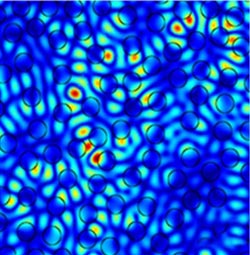Harnessing randomness to improve lasers

Computed optical light fields in a random laser overlaid on black circles, which represent the nanoholes drilled into a semiconductor quantum cascade laser, to produce a laser pattern with low spatial coherence.<br><br>© 2013 WILEY-VCH Verlag GmbH & Co. KGaA, Weinheim<br>
Randomly arranged items usually have poor optical properties. The rough—or random—surface of a frosted-glass window, for example, obscures the view of an object.
The optical industry therefore expends considerable effort reducing any surface irregularities in optical devices to avoid the uncontrollable scattering of light characteristic of random structures.
But now, a research group led by Ying Zhang from the A*STAR Singapore Institute of Manufacturing Technology (SIMTech) has made good use of randomness by studying how random structures can improve the performance of lasers. Together with a team led by Qijie Wang at Nanyang Technical University in Singapore, the group has demonstrated the world’s first electrically pumped mid-infrared random laser, which operates at a 10-micrometer wavelength. The laser is as bright as conventional diode lasers but produces less-speckled images.
Light waves from a conventional laser oscillate in perfect synchronicity, across both time and space. Perfect alignment of the light waves at different time and different locations across the beam profile is known as temporal and spatial coherence, respectively. When a laser illuminates a surface, a speckled pattern is typically visible, which indicates spatial coherence. The speckles result from the laser beam reflecting from different parts of the surface. Because the waves are in sync, they create spatial interference effects in the eye of an observer. This distortion is undesirable, particularly in biomedical imaging applications conducted in the infrared region of the spectrum.
Random lasers are the solution to this type of distortion, says Zhang. “Random lasers show the same high temporal coherence as that of other lasers but have a lower spatial coherence,” he explains. “High temporal coherence gives the desirable brightness but it is the low spatial coherence that removes the speckles caused by interferences.”
To realize a random laser in the mid-infrared spectrum, Zhang and co-workers used a semiconductor quantum cascade laser into which they had drilled a random pattern of nanoholes. At a sufficiently high density, these holes prevent the formation of a regular laser pattern within the semiconductor (see image). Instead, the pattern of a random laser forms, with low spatial coherence.
Employing a quantum cascade laser to realize the random lasers allows for the polarization of the laser light perpendicular to the laser surface. This propagation minimizes losses owing to the air-hole structure.
The research team’s wafer-fabrication competencies enabled them to drill holes deep enough into the laser chip, with sufficiently smooth side walls to minimize losses in the laser itself. By introducing these perfections and overcoming a number of other practical hurdles, Zhang and his colleagues succeeded in making the lasers efficient enough to provide lasing during electrical operation.
Nevertheless, notes Hou Kun Liang of SIMTech, who invented the mid-infrared random laser, more work is needed to bring random lasers to market. “We are working on a random laser that operates at room temperature. And in the long-term, we plan to extend random lasers from the infrared to even longer wavelengths and can be used for inspection of various polymer packaging quality-control of printed electronics, biomedical imaging, among other applications.”
About the Singapore Institute of Manufacturing Technology
The A*STAR Singapore Institute of Manufacturing Technology (SIMTech) develops high-value manufacturing technology and human capital to contribute to the competitiveness of Singapore’s industry. It collaborates with universities as well as multinational and local companies in the precision engineering, electronics, semiconductor, medical technology, aerospace, automotive, marine, logistics and other sectors.
Journal information
Liang, H. K., Meng, B., Liang, G., Tao, J., Chong, Y., Wang, Q. J. & Zhang, Y. Electrically pumped mid-infrared random lasers. Advanced Materials 25, 6859—6863 (2013).
Media Contact
All latest news from the category: Process Engineering
This special field revolves around processes for modifying material properties (milling, cooling), composition (filtration, distillation) and type (oxidation, hydration).
Valuable information is available on a broad range of technologies including material separation, laser processes, measuring techniques and robot engineering in addition to testing methods and coating and materials analysis processes.
Newest articles

Magnetic tornado is stirring up the haze at Jupiter’s poles
Unusual magnetically driven vortices may be generating Earth-size concentrations of hydrocarbon haze. While Jupiter’s Great Red Spot has been a constant feature of the planet for centuries, University of California,…

Cause of common cancer immunotherapy side effect s
New insights into how checkpoint inhibitors affect the immune system could improve cancer treatment. A multinational collaboration co-led by the Garvan Institute of Medical Research has uncovered a potential explanation…

New tool makes quick health, environmental monitoring possible
University of Wisconsin–Madison biochemists have developed a new, efficient method that may give first responders, environmental monitoring groups, or even you, the ability to quickly detect harmful and health-relevant substances…



